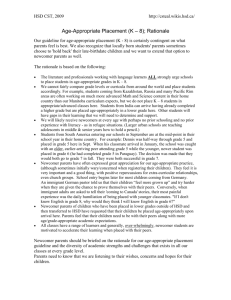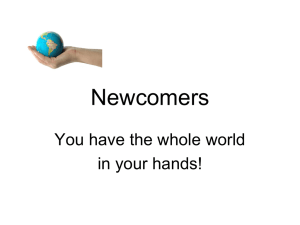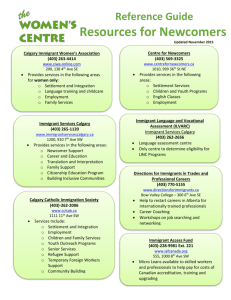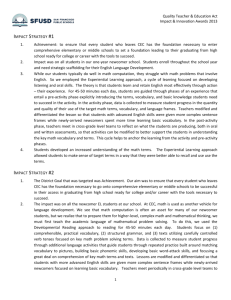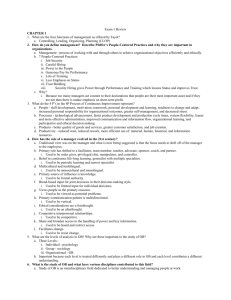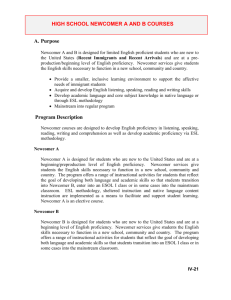Resources for Working with Newcomer Youth
advertisement
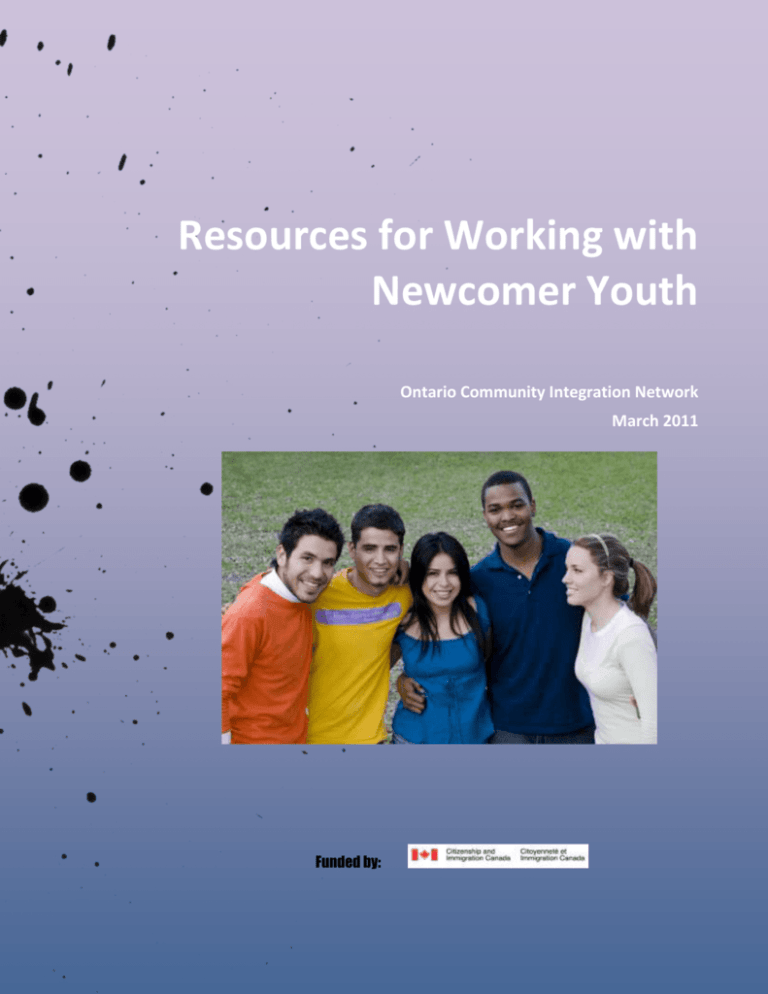
Resources for Working with Newcomer Youth Ontario Community Integration Network March 2011 Funded by: Table of Contents 1.0 Introduction ....................................................................... 1 1.1 Icons Used in this Guide ........................................... 2 2.0 Needs of Newcomer Youth ............................................... 3 3.0 Programming Principles and Best Practices .................. 6 4.0 Diversity and Inclusion ..................................................... 9 4.1 Organizational Development .................................... 9 4.2 Youth Learning ....................................................... 12 4.3 Older Youth and Adult Learning ............................. 15 4.4 Diversity Resources ................................................ 15 5.0 Workshop Activities for Youth ....................................... 16 5.1 Mostly Fun Activities ............................................... 16 5.2 Sports and Recreation ............................................ 17 5.3 Youth Leadership Training...................................... 18 5.4 Facilitation Skills ..................................................... 20 6.0 Engaging Youth............................................................... 21 7.0 Engaging Parents............................................................ 23 8.0 Risk Management............................................................ 25 9.0 Needs Assessment Surveys .......................................... 28 10.0 Program Evaluation ...................................................... 29 11.0 Mentoring ....................................................................... 31 12.0 Homework Clubs ........................................................... 32 13.0 Websites ........................................................................ 33 13.1 Mainly For Newcomer Youth .................................. 33 13.2 Mainly For Program Staff ........................................ 34 1.0 Introduction Programming for immigrant and refugee youth is a developing field. People who work with newcomer youth use approaches taken from both the settlement services sector and from mainstream youth programming. They are also flexible and experimental, open to learning from youth what works best. This guide collects some of the best ideas and materials that are currently being shared on the World Wide Web. In selecting items for inclusion here, priority was given to resources that: Contain useful tools Focus on youth1 Were developed for use with immigrants or refugees OR for diverse groups or communities Are Canadian All items included here are free, and readily available online (as are most of them), or by contacting the publisher through the website. Research studies are concentrated in Sections 2 and 3. These provide the basis for understanding the needs of newcomer youth and the principles behind successful programming; and identify best or promising practices for meeting needs. Starting with section 4, the focus is on practical resources for organizations and staff who work with newcomer youth. Every effort was made to include the best, most apt, and most useful resources. However, no tool is likely going to work for your program “straight out of the box”. You should expect to make some adaptations, taking into consideration your resources, the characteristics of the youth you work with, and your community. Based on the needs identified by newcomer youth and staff who work with them, this guide could potentially include many more sections. On many issues, no dedicated tools could be found. However, in some of these cases, you may still find that at least one of the more comprehensive manuals listed here addresses the topic in some way. Web links are current as of March 2011. If a particular link doesn’t work for you, it is very possible that the item is still available Within this guide, “youth” encompasses ages 12 to 24, although some specific resources apply to a more restricted age range. 1 RESOURCES FOR WORKING WITH NEWCOMER YOUTH 1 somewhere else on the Web. Try searching for the document title using Google or another web search engine. Or go to the root domain of the URL (everything up to and including the .com, .ca, .org, .net, for example) to access a home page and see if the site has an internal search function. This guide showcases some wonderful materials, many developed through approaches that engage and empower newcomer youth. An increasing number of newer resources are “youth to youth” — meaning that newcomer youth are the authors. This is definitely a best practice, and these items are marked with a “shooting star” icon. We owe sincere thanks to all the dedicated people who have recorded their successful approaches and shared them for the benefit of our newcomer youth. 1.1 Icons Used in this Guide Developed by youth for youth, or for use in youth programs Canadian Useful tools, such as: templates, exercises, checklists, and workshop materials Academic or community-based research Focus on immigrant and refugee issues, services, or programs Focus on youth issues, services, or programs Focus on diverse groups or communities 2 RESOURCES FOR WORKING WITH NEWCOMER YOUTH 2.0 Needs of Newcomer Youth It has been well over a decade since Canadian researchers first became interested in the issue of youth settlement and integration. At that time, the numbers of immigrant and refugee children and youth in Canada were growing. It was becoming evident that these young newcomers faced quite different opportunities and challenges from their parents; also that the needs of newcomer youth were not being well addressed by existing services. Consulting with newcomer youth, and with professionals who worked with them, researchers identified numerous and complex issues. These encompassed various age ranges and stages of development, numerous languages and cultures, different pre-settlement experiences, and compounding risk factors, such as poverty. Moreover, like any group of young people, newcomer youth have a wide range of individual aptitudes, interests, and goals in life. More recent studies have found that the issues for newcomer youth remain much the same today. However, researchers are now able to identify a number of promising or emerging best practices across Canada. Below are links to some important studies on newcomer youth issues. When new Canadian research results are published, they can most often be found on websites listed in Section 13.2. Information and Tools Newcomer Youth Settlement Guide for Service Providers, OCASI: Ontario Council of Agencies Serving Immigrants, September 2009 http://www.ocasi.org/index.php?qid=1018 Immigrant and refugee youth conducted the community-based research behind this report that identifies challenges for newcomer youth in Ontario and makes recommendations for effective settlement services. The youth researchers wrote a proposed Youth Bill of Rights. RESOURCES FOR WORKING WITH NEWCOMER YOUTH 3 All Kids Have Dreams, Cathy Taylor, Aspen Family and Community Network Society, 2005 http://www.aspenfamily.org/resources/Aspen_AKHD_09.pdf Immigrant youth in Calgary tell their own stories and provide commentary on various situations they and their peers face. The youth talk about risk and protective factors, gaps that need to be filled, and strategies for prevention and intervention. New Start for Youth Study: An Examination of the Settlement Pathways of Newcomer Youth, Susan S. Chuang, Associate Professor, University of Guelph & Canadian Immigrant Settlement Sector Alliance (CISSA), 2010 http://atwork.settlement.org/downloads/atwork/New_Start_for_Newco mer_Youth_CISSA_ACSEI_Report_En_Final.pdf Researchers asked youth in Alberta, British Columbia, Nova Scotia, Ontario, and Quebec about their adjustment and settlement experiences. A key recommendation is to look at newcomer youth settlement from a national perspective. Canadian Issues, Association for Canadian Studies, Spring 2005 http://canada.metropolis.net/pdfs/CITC_Spring_05_EN.pdf This issue has two articles based on recent research: 4 The New Canadian Children and Youth Study: Research to Fill a Gap in Canada’s Children’s Agenda by Morton Beiser, Linda Ogilvie, Joanna Anneke Rummens, Robert Armstrong and Jacqueline Oxman-Martinez Immigrant Children and Youth in Focus by Hieu Van Ngo and Barbara Schleifer RESOURCES FOR WORKING WITH NEWCOMER YOUTH Immigrant Youth in Canada, Canadian Council on Social Development, 2000 http://www.ccsd.ca/subsites/cd/docs/iy/index.htm Researchers held focus groups with newcomer youth in Montreal, Toronto and Vancouver and conducted a survey of agencies across Canada, including boards of education, community health centres, social services/child welfare agencies, police departments, public health departments, and settlement service providers. Between Two Worlds: The Experiences and Concerns of Immigrant Youth in Ontario, Kenise Murphy Kilbride, Paul Anisef, Etta Baichman-Anisef, and Randa Kattar, 2000 http://ceris.metropolis.net/virtual%20library/other/kilbride2.html Research with youth, their families, and service providers took place in Toronto, Kitchener and Ottawa. To Build on Hope: Overcoming the Challenges Facing Newcomer Youth at Risk in Ontario, Kenise Murphy Kilbride, Paul Anisef, 2001 http://atwork.settlement.org/sys/atwork_library_detail.asp?doc_id=100 2767&passed_lang=EN Consultations with youth and youth service providers in Toronto, Hamilton and Ottawa focussed on young newcomers “at risk”, meaning those having additional disadvantages such as poverty, visible minority status, lack of a community base, or lower levels of English. RESOURCES FOR WORKING WITH NEWCOMER YOUTH 5 The Needs of Newcomer Youth and Emerging Best Practices to Meet Those Needs, Paul Anisef, Kenise M. Killbride, The Joint Centre of Research on Immigration and Settlement (CERIS), 2000 http://atwork.settlement.org/sys/atwork_library_detail.asp?passed_lan g=EN&doc_id=1002327 The authors identify needs, service gaps, and best practices for supporting immigrant youth aged 16 to 20 in the areas of education, social services, employment, health and mental health. 3.0 Programming Principles and Best Practices Researchers and practitioners agree on certain characteristics of good youth programming, such as: Engaging youth — with fun activities, challenges, and opportunities they might not otherwise have Building relationships — so youth feel welcome and valued, which allows them to participate and learn Empowering youth — allowing them to be active players in the planning and delivery of programs Providing flexible program options — related to types of activities and when they are offered As no one program can meet all youth needs, another universal best practice is for staff to know what services are available in the community, so they can make referrals. Partnerships between organizations can bring about more opportunities and enhanced programs for the youth. When settlement programs are doing the outreach to potential partners, it’s important to scan widely. Some partnerships seem obvious or ideal to you, but the other organization does not respond. On the other hand, many community organizations and businesses and government departments have a mandate to reach diverse and newcomer youth, but they don’t know how to start. If you can bring them new outreach options, and help them to build their cultural competency, there will be benefits to both partners. 6 RESOURCES FOR WORKING WITH NEWCOMER YOUTH Information and Tools Section 2.0 Resources All of the studies listed in the previous section formulate recommendations for service providers and all levels of government. The newer studies also provide examples of existing programs that illustrate some best practices. Best Practices for Youth Programs, United Way of Greater Toronto, February 2005 http://www.unitedwaytoronto.com/downloads/whatWeDo/reports/Yout hBestPractices-FinalPublicReport.pdf Newcomers were not the focus of this research and consultation project, but newcomer and diverse youth are a major part of the youth demographic in Toronto. The report identifies asset-based practices for training and employment, integrating newcomers, social recreation, violence prevention, and engaging at-risk and marginalized youth in low-income neighbourhoods. Amplify: Designing Spaces and Programs for Girls: A Toolkit, Girls Action Foundation, 2010 http://www.girlsactionfoundation.ca/files/Amplify_2010_LR_0.pdf This manual has reflections and recommendations from girls' programmers across Canada on how to develop spaces and programming. This includes considerations for newcomer and culturally diverse participants. RESOURCES FOR WORKING WITH NEWCOMER YOUTH 7 Conversations for Change: An Overview of Services for Immigrant Children and Youth in Calgary, United Way of Calgary and Area, May 2004 http://www.ceris.metropolis.net/Virtual%20Library/EResources/Hurlock McCullaghSchissel2004.pdf Priority areas of need are: coordinated services, cultural competency, inclusive program development, and partnership opportunities. The study concludes that it is too early to identify “best” practices, because there are no standards for doing so. Researchers looked widely for emerging “promising” practices. prACTice Matters, December 2004: Creating Successful Programs for Immigrant Youth, ACT for Youth Upstate Center of Excellence http://www.actforyouth.net/documents/prACTice_Dec04.pdf This newsletter identifies strategies for working with youth, parents and schools. This resource is most interesting because it begins with Four Assets of Immigrant Youth (rather than with their challenges). These are: the protection provided by their cultural values; (for most) their bilingualism; the development spurred by their migration struggles; and the resiliency and skills developed through juggling two cultures. Best Settlement Practices: Settlement Services for Refugees and Immigrants in Canada, Canadian Council for Refugees, 1998 http://ccrweb.ca/bpfina1.htm This is an influential source outlining the principles behind settlement services in Canada. This was the basis for a later discussion of a National Settlement Service Standards Framework: http://ccrweb.ca/standards.htm 8 RESOURCES FOR WORKING WITH NEWCOMER YOUTH 4.0 Diversity and Inclusion As they are exploring themselves and their place in society, newcomer youth are especially sensitive to issues of diversity and inclusion. Effective services start at the organizational level, with organizations that constantly assess their cultural competency and accessibility; and work on problems or gaps. Resources in this section also include workshop materials for young people to learn about and discuss topics such as racism, stereotyping and exclusion. 4.1 Organizational Development Information and Tools Inclusive Community Organizations: A Tool Kit, Ontario Healthy Communities Coalition, October 2004 http://www.ohcc-ccso.ca/en/inclusive-community-organizations-a-toolkit This resource is useful for community organizations that want to increase their capacity to include diverse groups in a way that is appropriate for both those groups and for the organization. Groups specifically covered include: Aboriginal peoples, ethno-racial groups, youth, persons with disabilities, all sexual orientations and gender identities. The kit covers how build a strategy and enhance knowledge and skills within the organization. It includes practical tools, such as for planning inclusive events, conducting focus groups, and evaluating success. RESOURCES FOR WORKING WITH NEWCOMER YOUTH 9 Guidebook for Diversity and Organizational Change, North Shore Multicultural Society http://www.nsms.ca/Downloads/diversity.pdf This resource from British Columbia provides guidelines and tools for organizations to incorporate diversity throughout their operations. It uses a four-stage model: Define, Discover, Discuss, and Develop. Toward Cultural Competency: A Practical Guide to Facilitate Active Participation of Culturally Diverse Families In Schools, Hieu Van Ngo, Coalition for Equal Access to Education, 2003 http://www.eslaction.com/main/school%20cultural%20competency%2 0manual.pdf The statistics and context relate to Calgary, but most of the tools in this guide can be adapted for other locations. Cultural competency is described as a process. There are tools for self-assessment and planning, and materials for two training workshops. Preparing Staff to Work with Immigrant Youth, National Collaboration for Youth http://www.nydic.org/nydic/staffing/workforce/PreparingStafftoWorkwi thImmigrantYouth.htm This American resource has practical tips for hiring, developing and retaining staff who work with immigrant youth. The same page has a link to Training Staff to Work with Immigrant Youth, a manual with instructions for training modules that are 45 minutes to 1 hour in length. 10 RESOURCES FOR WORKING WITH NEWCOMER YOUTH ID Booklet: Ideas for Inclusion and Diversity, SALTO-YOUTH http://www.salto-youth.net/downloads/4-17-1050/IDbooklet.pdf This European resource is for youth workers and others working directly with young people. It provides tools for reaching a diverse target audience and for making projects and organizations more inclusive. [SALTO-YOUTH = Support and Advanced Learning and Training Opportunities within the YOUTH in Action program. Youth in Action provides young people with non-formal learning experiences.] Building Culturally and Linguistically Competent Services to Support Young Children, Their Families, and School Readiness, Kathy Seitzinger Hepburn, M.S., 2004 http://www.eric.ed.gov:80/PDFS/ED485881.pdf This online tool kit defines cultural and linguistic competence for community services. It deals with: diversity and the cultural context of the family and community; understanding the impact of culture on child development; planning and implementing culturally and linguistically competent services. The focus of the tool is on early childhood services and school readiness, but most of the principles are widely applicable. All Abilities Welcome Toolkit http://www.spra.sk.ca/Default.aspx?DN=7c27c581-e292-4120-a105e8acdf48b378 This toolkit has information, advice and checklists to help programs and service providers be inclusive to people of all abilities. Print copies can be ordered through the All Abilities Welcome website: http://www.allabilitieswelcome.ca/ RESOURCES FOR WORKING WITH NEWCOMER YOUTH 11 4.2 Youth Learning Information and Tools The Kit: A Manual for Youth to Combat Racism Through Education, The United Nations Association in Canada, 2002 http://www.unac.org/yfar/The_Kit.pdf This resource was created by youth for youth. It includes a variety of interactive workshops and activities dealing with racism. There are complete instructions for workshop delivery, with templates for everything from workshop invitations through to evaluation and thank yous. People Power, North Shore Multicultural Society http://www.nsms.ca/Downloads/People_Power_booklet.pdf The youth and youth workers who developed this resource describe People Power as a process whereby youth develop the skills for appreciating diversity and being an active part of creating an inclusive society. The manual is an interactive and flexible learning tool that deals with stereotyping, prejudice and various “isms” in society. Celebrating Diversity, Classroom Connections, 2000 http://www.classroomconnections.ca/en/celdiversity.php Classroom Connections works with major education organizations and a network of teachers across Canada to develop and pilot test new resources for classrooms. Celebrating Diversity is designed for use in grades 4-8. The materials include instructions for activities to foster inclusive classrooms and appreciation for diversity. 12 RESOURCES FOR WORKING WITH NEWCOMER YOUTH Strangers Becoming Us, Classroom Connections, 2001 http://www.classroomconnections.ca/en/sbuelementary.php Strangers Becoming Us presents classroom-ready activities about multiculturalism, citizenship, and what it means to be a new Canadian. It is available in two versions: for Grades 5-8 social studies and ESL programs and for Grades 9-12. The secondary school version includes case studies, political cartoons, and activities that explore coming to Canada as an immigrant or as a refugee, the historical treatment of new Canadians and the stresses that occur for youth that live between two cultures. Audio CDs of radio show style content originally accompanied the manuals. Contact Classroom Connections through the website to request the CDs and/or transcripts of their content. ThinkB4YouSpeak, Gay, Lesbian and Straight Education Network (GLSEN) http://www.thinkb4youspeak.com/ ThinkB4YouSpeak is a campaign to help students learn about the negative consequences of homophobic language and anti-LGBT bias. The website has awareness materials and a teacher’s guide. Social Inclusion T-Kit, Council of Europe and European Commission, 2003 http://youth-partnership-eu.coe.int/youth-partnership/publications/Tkits/8/Tkit_8_EN This manual has an explanation of the issues (in the European context) and exercises for youth group work on topics that include: young people with fewer opportunities, feeling social exclusion, building trust and self-esteem, conflict management, setting up partnerships, and peer education. RESOURCES FOR WORKING WITH NEWCOMER YOUTH 13 Intercultural Learning T-Kit, Council of Europe and European Commission, 2000 http://youth-partnership-eu.coe.int/youth-partnership/publications/Tkits/4/Tkit_4_EN There is a bit of background and theory on culture and intercultural learning (in the European context), followed by many exercises for youth groups: energizers, individual reflection, discussion, simulations and role plays, problem solving, and evaluation. There are also examples of weekend workshops built from the exercises. COMPASS: A manual on human rights education with young people DOmino: A manual to use peer group education as a means to fight racism, xenophobia, anti-semitism and intolerance Education Pack All Different — All Equal Three resources from the Council of Europe http://eycb.coe.int/compass/default.htm COMPASS, All-Different – All Equal, and DOmino are complementary works on human rights, diversity, and anti-racism for young people. Each is a comprehensive online manual with background, guidelines for facilitators, and instructions for activities. 14 RESOURCES FOR WORKING WITH NEWCOMER YOUTH 4.3 Older Youth and Adult Learning Information and Tools Why and How to Deal with Prejudice: A Guide for Newcomers, Rubin Friedman, Jewish Family Services of Ottawa http://www.jfsottawa.com/antiprejudice/theprinciples_en.html Using language and content geared to newcomers, this booklet explains rights and obligations under the Canadian Charter of Rights and Freedoms. It explains how to recognize and deal with prejudice within oneself; as well as how someone can take action when they encounter prejudice personally or within society. Speak Up – Teaching Tolerance, Southern Poverty Law Center http://www.tolerance.org/handbook/speak/speak This resource uses real stories of racism, bigotry and bias related to race, religion, age, ethnicity, disability, gender or sexual orientation. Content on every topic answers the question “What Can I Do?” — at work, within family, or at school, for example. There is an outline for a short workshop, and a personal pledge form. 4.4 Diversity Resources Canadian Race Relations Foundation Glossary http://www.crr.ca/component/option,com_glossary/Itemid,553/lang,en glish/ An online dictionary of terms from “ableism” to “xenophobia”. RESOURCES FOR WORKING WITH NEWCOMER YOUTH 15 Words with Dignity http://www.uofaweb.ualberta.ca/ssds/wordswithdignity.cfm This is a list of preferred terms for referring to persons with disabilities. LGBT Definition of Terms http://geneq.berkeley.edu/lgbt_resources_definiton_of_terms Multicultural Calendar http://www.malkam.com/en/15.0.asp There are a great number of multicultural calendars online. This one, maintained by an Ottawa business, includes an explanation of each culturally significant date. 5.0 5.1 Workshop Activities for Youth Mostly Fun Activities These are activities that can be done by themselves or as elements of your programs or youth sessions. Information and Tools Jabbertalk: A Methodology for International Youth Work, Don Bosco Youth-Net IVZW, Council of Europe http://www.donboscoyouth.net/node/69 This manual contains tested activities for working with multicultural youth groups. Most of the activities are grouped according to a type of expression: oral, non-verbal, dance, manual, and musical. There are also sections on teamwork, values, and communications; and a chapter on the use of video as a tool for observation and feedback. 16 RESOURCES FOR WORKING WITH NEWCOMER YOUTH Stress Reduction Activities for Students, San Francisco Unified School District http://healthiersf.org/Resources/pubs/stressRed/StressReductionActivit ies.pdf These exercises use breathing and relaxation techniques, imagery, physical and artistic expression. The Source for Youth Ministry http://www.thesource4ym.com/ This evangelical Christian youth site has a “Free Resources and Ideas” area that is too good to miss. There are many, many creative and fun activities that require no adaptation to appeal to diverse youth groups. They are well-presented and well-organized for facilitators. For example, under “Games and Icebreakers”, some of the categories are: mixers, big room games, outdoor games, games with a point, and sick and twisted games. 5.2 Sports and Recreation These are activities that get young people moving and help them learn physical skills. Some benefits of being active are the same for all young people, such as increased physical well-being and confidence. For newcomers, sports and recreational activities can also be pathways to integration and social networking. RESOURCES FOR WORKING WITH NEWCOMER YOUTH 17 Information and Tools Inclusive Model for Sports and Recreation Programming for Immigrant and Refugee Youth, OCASI: Ontario Council of Agencies Serving Immigrants, 2006 http://www.ocasi.org/index.php?catid=130 This Model for Sports and Recreation Programming for Immigrant and Refugee Youth was developed through testing by youth settlement program staff in Toronto, Hamilton, and Ottawa. The document includes “Twelve Elements Essential to an Effective Sports and Recreation Program for Immigrant and Refugee Youth”. Fit for Life: Using sports as an educational tool for the inclusion of young people with few opportunities, SALTO, 2005 http://www.saltoyouth.net/rc/inclusion/inclusionpublications/inclusionforall/fitforlife/ This resource describes the benefits of including sports in youth programs, with examples from Europe. The chapter on Methods for Getting Started has many games and activities that require little or no equipment. 5.3 Youth Leadership Training In keeping with the best practice approach of “youth to youth”, these resources are designed to train youth to be peer educators. 18 RESOURCES FOR WORKING WITH NEWCOMER YOUTH Information and Tools Manual for Violence Prevention with Immigrant and Refugee Youth, Strengthening Families in Canada (SFIC), Phase Two: Youth Group, 2008 http://www.serc.mb.ca/content/dload/download.2008-1028.9116717055/file The title of this manual is misleading. In fact, it has complete guides for workshops on these topics: 1. Introduction to the Workshop, Cultural Adaptation and Acculturation Session 2. Communication and Tools for Effective Communication 3. Self Esteem 4. Interpersonal Violence and Domestic Violence 5. Youth Sexuality, Birth Control and STI’s/HIV 6. Stress Management/Maintaining Mental Health 7. Internet Safety There are four additional workshops for Peer Resource Training. Graduates are prepared to be peer supporters in their community. The workshops were designed following a community and youth engagement process, also described in the document. PEERing In PEERing Out: Peer Education Approach in Cultural Diversity Projects, SALTO Youth http://www.salto-youth.net/downloads/4-17972/Peer_Education_Approach_in%20Cultural_Diversity_Projects.pdf This manual records the content of a training course for European youth working in cultural diversity projects. The goal was to train them to be peer educators. The training covers: leadership, facilitation, communication, group processes, and project management. RESOURCES FOR WORKING WITH NEWCOMER YOUTH 19 5.4 Facilitation Skills Most of the training manuals listed above provide quite a bit of guidance for facilitators. In addition to leading the agenda, and bringing out participant contributions, youth facilitators have to create a safe environment and maintain an enthusiastic, fun approach. Information and Tools How to Facilitate a Meeting, Amnesty International http://www.amnesty.ca/youth/youth_action_toolkit/how_to_facilitate_ meeting.php Part of a Youth Action Toolkit, this is a one page introduction to the role of a facilitator. The same online toolkit has tips for group brainstorming and ideas for meeting “icebreakers”. Leading Youth to Lead, A Guide for Facilitating Youth Facilitation, Student Support Services Department, San Francisco United School District http://www.healthiersf.org/ExCELafterschool/Resources/TechnicalAssistance/guide/Meeting%20Facilitation%20Tips%20for%20Youth%2 0PDF.pdf This is a practical resource for “adult allies” to support youth facilitators. There are simple tips for the facilitators, a sample agenda, meeting rules and roles, and an action items template. The example is planning a dance party, but the tools are widely applicable. 20 RESOURCES FOR WORKING WITH NEWCOMER YOUTH Basic Facilitation Skills, The Human Leadership and Development Division of the American Society for Quality The Association for Quality and Participation The International Association of Facilitators, 2002 http://www.uiowa.edu/~cqi/2002BasicFacilitationPrimer.pdf This is a primer for people new to facilitation. It includes tips for dealing with common situations, such as staying on time, dealing with sidebar conversations or never-ending discussions. 6.0 Engaging Youth Youth engagement is about fostering active citizenship, which is one of the goals of newcomer integration. Youth engagement also relates to involving youth in how your program or organization is run, and giving them in a voice in decisions that affect them. Information and Resources Volunteering Eh Toolkit, Kitchener-Waterloo Multicultural Centre, 2010 http://www.volunteeringeh.com/Tool%20Kit/toc.html This online toolkit has activities, templates, questionnaires, web links, and other useful materials for youth and for program staff who work with current or prospective newcomer youth volunteers. Each section title on the Table of Contents page is a link, and each toolkit page may be downloaded as a Word or PDF document. RESOURCES FOR WORKING WITH NEWCOMER YOUTH 21 InvolveYouth2: A Guide to Meaningful Youth Engagement, City of Toronto, 2006 http://www.toronto.ca/involveyouth/pdf/youth2inal.pdf This approach to youth engagement emphasizes access, equity and social justice. The manual draws on the experience of youth workers in providing program activities and approaches that meaningfully engage youth and help young people gain new skills. OTF Youth Engagement Tool, Ontario Trillium Foundation, 2009 http://www.trilliumfoundation.org/cms/en/html/GrantSeekers/youth_e ngagement.aspx The web page shows a youth engagement spectrum, and provides questions to help you assess your organization’s level of youth engagement. There is a link to Building Ontario’s Youth Social Infrastructure to Transform and Sustain Youth Engagement and Organizing, the diagrammatic output of a “think tank” of youth visionaries. Resource Guide for Immigrant and Refugee Youth, Environmental Youth Alliance, 2010 http://practicalradical.files.wordpress.com/2010/07/immigrant-andyouth-refugee-guide.pdf Written by and for immigrant and refugee youth, this is a guide to getting around Vancouver. The information is mostly specific to that city, however this document is a model for a useful resource that could be produced by youth anywhere in Canada. 22 RESOURCES FOR WORKING WITH NEWCOMER YOUTH Youth First: A Guide to Help Youth Take Action, Education, Culture and Employment, Northwest Territories http://www.ece.gov.nt.ca/Publications/PDF%20Publications%20Files/P ublications%20New/Youth%20First.pdf This resource has many guidelines and tips for youth who want to plan and fundraise for new programs. Let Discussion Guide Us: Decision Making — How should children and youth participate in decisions about them?, Centres of Excellence for Children’s Well-Being http://www.engagementcentre.ca/files/YDMGuide_web_e.pdf This document explains the background and activities of an ongoing initiative to engage youth across Canada in a discussion about the concept of a national youth body. Anyone can host a group. This document provides questions to guide the discussion and information about sharing the ideas that come out of the discussion. 7.0 Engaging Parents Outreach to youth very often entails engaging their parents as well. Language and cross-cultural skills will be helpful to building trust. Program staff also require an understanding of the settlement experience. Schools have taken the lead in recording and sharing some of their successful approaches. RESOURCES FOR WORKING WITH NEWCOMER YOUTH 23 Information and Tools Toward Active Parental Participation: A Practical Guide to Working with Immigrants, Hieu Van Ngo, Coalition for Equal Access to Education, 2002 http://www.eslaction.com/main/parent%20training%20manual.pdf This train-the-trainer guide has complete facilitator notes and materials for 10 workshops. The content of over half of them are specific to the educational system in Calgary, Alberta. The rest, including “Effective Leadership” and “Issues Facing Immigrant Children and Youth” have wider application. Beyond the content, this manual is a model, in that it was developed with the input and feedback of immigrant parents. The training uses participatory processes so that immigrant parents can reflect upon their shared experiences and draw upon their cultural strengths. The goal is for them to take individual and collective action to address barriers to participation. See also the Coalition’s manual: Toward Cultural Competency: A Practical Guide to Facilitate Active Participation of Culturally Diverse Families In Schools, listed in Section 4.1. Parent Involvement in School: Engaging Immigrant Parents, Wilder Research, 2009 http://www.wilder.org/download.0.html?report=2262 This resource provides a “snapshot” of some proven strategies. 24 RESOURCES FOR WORKING WITH NEWCOMER YOUTH Successful Practices for Immigrant Parent Involvement: An Ontario Perspective, Mary Ladky and Shelley Stagg Peterson, School of Education and Professional Learning, Trent University, March 2008 http://edst.educ.ubc.ca/sites/edst.educ.ubc.ca/files/courses/eadm/Lad ky%20and%20Peterson%20Successful%20Practices%20for%20Immig rant%20Parent.pdf The researchers surveyed 21 immigrant parents, as well as teachers and principals. Building Partnerships with Immigrant Parents, Andrea Sobel and Eileen Gale Kugler, Educational Leadership, March 2007 http://www.embracediverseschools.com/images/Ed_Leadership.pdf An American school with a large immigrant parent population has developed an innovative parent outreach program. The Community Youth Outreach Programme In Delta, British Columbia, Canada: "The Personal Touch That Works", Sherman Chan, Hardeep Thind and Lesley Lim, 2000 http://pi.library.yorku.ca/ojs/index.php/refuge/article/viewFile/22058/2 0726 Academic researchers capture some of the issues for newcomer families and some innovative approaches used to provide language and cultural interpretation and school-based initiatives for youth and their families. 8.0 Risk Management Some risk is inherent in good programming for youth: you can’t expect to avoid it entirely. Your organization should consider and demonstrate its duty of care to its board, employees, clients, volunteers and the RESOURCES FOR WORKING WITH NEWCOMER YOUTH 25 public. This section lists references related to organizational policies and practices, as well as useful tools that program staff can implement. Information and Tools Imagine Canada: Insurance and Liability Resource Centre for Non-Profits http://nonprofitrisk.imaginecanada.ca/ The resource centre of the site has tip sheets, tools, and columns by experts on common issues. Non-profit organizations may contact Imagine Canada with questions or to request customized training. Developing a Risk Management Strategy: Five Steps to Risk Management in Nonprofit and Charitable Organizations http://nonprofitscan.imaginecanada.ca/files/nonprofitscan/kdccdc/guide_kowalski_risk_eng.pdf This provides an overview of what’s involved in developing a risk management strategy, and provides tips and checklists. The Boundary Form: A Simple and Powerful Risk-Management Tool, David Hartley, Imagine Canada, 2010 http://nonprofitrisk.imaginecanada.ca/files/insuranceinfo/en/publicatio ns/boundary_form.pdf A boundary form outlines what a volunteer must not do, as opposed to a job description that explains what they should do. The list of prohibited actions should be short and memorable, and explain the consequences for prohibited actions. 26 RESOURCES FOR WORKING WITH NEWCOMER YOUTH Scouts Canada ByLaw, Policies and Procedures http://www.scouts.ca/dnn/scouters/BPPAdmin/BylawPoliciesandProced ures/ElectronicVersionBPandP/tabid/232/Default.aspx Relevant to Risk Management, Section 7000 Duty of Care provides a code of conduct for adults working with minors. It covers relationships, language, discipline, discrimination, physical contact, responsibilities to parents and youth, and procedures for handling allegations of harassment or abuse. Section 13000 is the Scouts’ Risk Management Policy. Volunteer Driving, Imagine Canada Insurance and Liability Resource Centre for Nonprofits http://nonprofitrisk.imaginecanada.ca/node/885 This page has links to various articles and tools including: Volunteer Transportation Guide: A Screening Tool (Canada) Volunteer Driver’s Handbook (UK) Driver’s Pledge (US) Our Community: Building Stronger Communities through Stronger Community Organizations http://www.ourcommunity.com.au/insurance/insurance_article.jsp?arti cleId=1244 This page of an Australian website has checklists to help organizations identify risks inherent in certain types of activities and to think about ways to manage the risks. RESOURCES FOR WORKING WITH NEWCOMER YOUTH 27 9.0 Needs Assessment Surveys Surveys of youth interests and preferences will help you identify priorities and make programming decisions. Additionally, the needs assessment process is a way to engage with youth in your community. When youth play a role in designing and administering a survey, they will feel, and encourage their peers to feel, that you are asking questions because you really want to know and will respond to the answers. Information and Tools Online Survey Sites Questionnaires are the most popular method of doing needs assessments. A number of websites offer online survey hosting services. These services are not free, unless you have a very short survey and a small group to consult with. But even if you don’t plan to use their services, these sites all have many helpful tips and guidelines for designing survey questions. SurveyMonkey Zoomerang http://www.surveymonkey.com/ http://www.zoomerang.com/ PollDaddy QuestionPro www.polldaddy.com http://www.questionpro.com/ Survey Gizmo Fluid Surveys http://www.surveygizmo.com/ http://fluidsurveys.com 28 RESOURCES FOR WORKING WITH NEWCOMER YOUTH Microsoft Office http://office.microsoft.com Survey templates in Word are available as free downloads. These can save you a lot of time in formatting a good-looking survey. You can also download copyright-free photos and clip art. Conducting Needs Assessment Surveys, The Community ToolBox http://ctb.ku.edu/en/tablecontents/sub_section_main_1042.aspx This toolbox has tips for designing and administering community surveys. 10.0 Program Evaluation Your program evaluation should provide you with useful information on areas where your program is successful, and how it might be changed to have more impact or represent better value for your investment. The results of an evaluation may also be helpful for writing funding proposals and doing program promotion. Youth should be involved in program evaluation. This will give them a voice and lead to their feeling ownership of the program. RESOURCES FOR WORKING WITH NEWCOMER YOUTH 29 Information and Tools Jabbertalk: A Methodology for International Youth Work, Don Bosco Youth-Net IVZW http://www.donboscoyouth.net/node/69 Most often, feedback is gathered orally or in writing. A chapter in this manual covers those methods, as well as more innovative and effective ways to collect the opinions of youth participants. There are, for example, methods based on: walking, manual expression (drawing or other art), and drama. The Kit: How Youth Can Evaluate Their Services, Youth Services Bureau of Ottawa-Carleton, 1998 http://www.ysb.on.ca/uploads/documents/factsheets/The-Kit.pdf Youth who did an evaluation of an Ottawa drop-in program prepared this youth-friendly, hand-crafted kit so others could reproduce their experience. Participatory Evaluation with Young People, Barry Checkoway & Katie Richards-Schuster, Youth and Community School of Social Work University of Michigan http://www.ssw.umich.edu/public/currentProjects/youthAndCommunity /pubs/youthbook.pdf This workbook leads young people through the “whys” and “hows” of an evaluation: planning, gathering information, analyzing data and reporting. Youth are advised to include multicultural communities in designing and implementing their evaluation. 30 RESOURCES FOR WORKING WITH NEWCOMER YOUTH A companion document provides additional information and tools for “adult allies”. It is: Facilitator’s Guide for Participatory Evaluation with Young People, Barry Checkoway & Katie RichardsSchuster, Youth and Community School of Social Work University of Michigan http://www.ssw.umich.edu/public/currentprojects/youthandco mmunity/pubs/guidebook.pdf The two resources provide more formal and complete coverage of the topic of evaluation. Project Evaluation Guide for Nonprofit Organizations, Fundamental Methods and Steps for Conducting Project Evaluation, Fataneh Zarinpoush, Imagine Canada, 2006 http://library.imaginecanada.ca/files/nonprofitscan/en/csc/projectguide _final.pdf Participatory Evaluation Essentials: An Updated Guide for Nonprofit Organizations, Anita M. Baker, Ed.D., Beth Bruner, The Bruner Foundation, 2010 http://brunerfoundation.org/ei/docs/EvaluationEssentials2010.pdf 11.0 Mentoring Mentoring is a proven tool in the settlement services field. Depending on a newcomer’s needs, it can effectively support language learning, education or job search, or provide cultural or social guidance. RESOURCES FOR WORKING WITH NEWCOMER YOUTH 31 Information and Tools Immigrant and Refugee Youth: A Toolkit for Program Coordinators, Mentor/National Mentoring Partnership, 2009 http://www.mentoring.org/downloads/mentoring_1197.pdf This toolkit covers the principles of mentoring for immigrant youth, planning and managing a program, finding and preparing mentors, and supporting the mentoring relationships. It includes training exercises, guidelines and checklists, and tools, such as a sample mentor job description. Tools for Mentoring Adolescents, Search Institute and Mentoring Partnership of Minnesota http://www.search-institute.org/mentoring/tools-mentoringadolescents This page has links to ten tip sheets for mentors. #7 deals with the influence of culture. 12.0 Homework Clubs The resource listed here is for a formal model of one-to-one tutoring, but it has some useful ideas and tools. Most homework clubs for newcomer youth are operated on a drop-in basis with volunteer tutors who are usually older youth or young adults. In this model, the social interactions are as important as the academic support. 32 RESOURCES FOR WORKING WITH NEWCOMER YOUTH Information and Tools Homework Clubs: How to Set Them Up, How to Run Them, Frontier College 2006 http://www.edu.gov.on.ca/eng/studentsuccess/learning/files/homewor k.pdf This manual presents the collective knowledge and experience of Frontier College, school teachers, literacy workers, and community centre staff. The appendices have templates for many common administrative documents. 13.0 Websites 13.1 Mainly For Newcomer Youth New Youth: Survival Info for Young Newcomers in Ontario http://www.newyouth.ca/ New Youth has information about school, work, immigration, law, health and daily life, as well as news and an events calendar. Canadian Council of Refugees Youth Network http://www.ccrweb.ca/eng/about/youth.htm The CCR Youth Network gives youth and youth allies a voice to address challenges faced by newcomer youth and a space to share ideas on how to meet these challenges. The main site has links to the Network’s pages on Facebook and YouTube. EXPRESS – Newcomer and Immigrant Youth Project http://www.soytoronto.org/current/express.html A project of Supporting Our Youth (SOY) based in Toronto, EXPRESS provides support for queer and trans youth between 16 and 29 who are immigrants, newcomers to Canada, refugees, refugee claimants, and non-status. RESOURCES FOR WORKING WITH NEWCOMER YOUTH 33 EXPRESS youth have created “The Newcomer/Immigrant Queer & Trans Ontario Youth Guide”. The guide can be obtained by contacting SOY (details at the website); and it may appear in an online format sometime in the future. Alone in Canada: 21 ways to make it better, a self-help guide for single newcomers, Centre for Addiction and Mental Health, 2001 http://www.camh.net/About_Addiction_Mental_Health/Mental_Health_ Information/alone_in_canada.html The audience for this book is young adult newcomers. It presents reallife examples of typical problems that people face living in a new culture. Each chapter ends with tips or exercises to solve problems and stay healthy. Alone in Canada is available in English, French and 16 other languages. 13.2 Mainly For Program Staff Settlement At Work http://atwork.settlement.org/atwork/home.asp This is a portal for all news, information, and resources related to newcomer issues and settlement services in Ontario and Canada. As of spring 2011, older pages remain available, with newer content appearing on the SettlementAtWork wiki: http://wiki.settlementatwork.org/wiki/Main_Page Learning AtWork http://learnatwork.ca/ This is an eLearning website hosted by OCASI (Ontario Council of Agencies Serving Immigrants) to support the professional development of those working with newcomers to Ontario. Youth program modules are in development for 2011. 34 RESOURCES FOR WORKING WITH NEWCOMER YOUTH The New Canadian Children and Youth Study http://www.nccys.com/ The New Canadian Children and Youth Study (NCCYS) is a national study of about 4,000 children and their families from sixteen different ethnocultural communities across Canada. It is a longitudinal study of children’s physical health and mental health, and of the factors that affect children's health, growth, development and fulfillment of their potential. It aims to provide a knowledge base for effective policy and practice, towards the development of a National Children’s Agenda. SWIS: Settlement Workers in Schools http://www.swisontario.ca/ The resources section of this site has many items that might be of interest to those who work with newcomer youth, in addition to those listed in previous sections. CERIS-Metropolis Library http://ceris.metropolis.net/frameset_e.html CERIS is a source for research that focuses on the resettlement and integration of immigrants and refugees in Ontario. Use the search function to find research papers and conference presentations on any subject. The site also has a number of older studies not listed here that are specific to a municipality or to a particular ethnic, cultural or language group. Opening Doors Project http://www.toronto.cmha.ca/ct_PDFs/OpeningDoorsBrochure.pdf This project offers free workshops for newcomer communities, immigrant and refugee serving agencies, and mental health services organizations within Ontario. Topics include anti-racism, mental health and the immigration experience, and culturally diverse self-care strategies. RESOURCES FOR WORKING WITH NEWCOMER YOUTH 35 All Abilities Welcome http://www.allabilitieswelcome.ca/en/index.htm All Abilities Welcome is a campaign of the Active Living Alliance for Canadians with a Disability (ALA) to help organizations be inclusive to all members of the community and be a part of promoting healthy Active Living for everyone. SALTO-YOUTH.net http://www.salto-youth.net/ This site has many youth work and youth training resources, a number of which are listed in this guide. [SALTO-YOUTH = Support and Advanced Learning and Training Opportunities within the YOUTH in Action program. Youth in Action provides young people with nonformal learning experiences.] 36 RESOURCES FOR WORKING WITH NEWCOMER YOUTH
